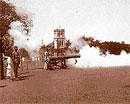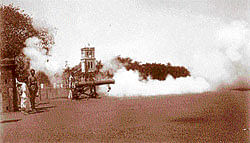

Though the British left India 64 years ago, their legacy lives on, in the coastal districts of Dakshina Kannada and Udupi (and many other parts of Karnataka), be it in the form of the institutions they built, the strong bridges they constructed, or their culture and tradition.
Among the many historic structures is a graveyard with tombs of more than 70 British nationals. Each epitaph in the graveyard located on Telecom House (earlier known as Old Kent Road) in the heart of Mangalore tells tales of Europeans.
The 211-year-old cemetery was exclusive to people of British origin who left their homeland never to return again. Prominent among them is the 20-foot-tall obelisk in memory of Brigadier-General John Carnac. The epitaph on his grave reads: “He distinguished himself by the important victory over Shah Zaddah in the year 1761 and in both stations, his zeal for public service, integrity and disinterested conduct were equally conspicuous.” He died in Mangalore on November 29, 1800. Brigadier-General John Carnac was second in command to Robert Clive during the Battle of Plassey, one of the highlights of Indian history.
Michael Thomas Harris, the fifth Collector of the erstwhile Canara district, who passed away on May 17, 1824, was also laid to rest in this cemetery.
The contribution of Harris, a man of vision, to the district has been significant. According to ‘Officialising Clandestine Practices of Environmental Degradation in the Tropics’ for the Harvard Center for Population and Development Studies, New York, there are references of a plaque in the office of the Divisional Commissioner, Mangalore which notes that in 1823, Collector Harris passed orders granting kumki rights to cultivators in the Canara District, whereby waste lands adjacent to agricultural fields could be used by the cultivator to satisfy the cultivators’ biomass needs.”
Apart from these two men, there were many more prominent Europeans who held notable posts in the then Canara district and those buried here include Capt Thomas Cosmo Gordon, who died on October 9, 1809, at the age of 38 years; Major General Charles William Taylor and his wife Sophia of Madras Regiment, 1885; James Hungerford Morgan, an industrialist, who died in 1885, at the age of 64 years; Capt William Shotton, who died in 1912, at the age of 36 years; John Le Mesurior, a mining engineer, who died on October 30, 1899; James Per, the commander of the ship Bussor Merchant of London, who died in 1811; Lieutenant Charles Gowan, (belonging to the Company’s marine on the Bombay establishment), who died of fever on March 24, 1814, at the age of 33 years and Captain Neil McNeil of the 50 regiment in Madras Infantry who died in 1827.
Karnataka Theological College Archives Assistant Benet Amanna points out that the KTC library has a register which gives a detailed account of Europeans, a wonderful source for historians to study the British legacy in Mangalore.
The beginning
It is interesting to note that St Paul’s church near Nehru Maidan in Mangalore, the only Anglican church in the coastal districts was consecrated on January 5, 1843. But the first person was laid to rest in the cemetery on November 29, 1800 (Brigadier-General John Carnac), which means that the cemetery is much older than the oldest church in the erstwhile Canara district.
Dr T A Koshy, one of the oldest members of St Paul’s church, now 78, points out that a certain Thomas, a section officer at PWD in Cannanore, arrived in Mangalore soon after Indian Independence and handed over the records and keys of the cemetery to J N A Hobbs, the then secretary of pastorate committee (who was later knighted).
“Titus Joseph and Prof C L Mathai took a keen interest in church matters and kept the St. Paul’s church going,” he recalls and adds that the South India Cemetery Board under the UK High Commission had classified the cemetery as ‘Closed but not abandoned’ (the other two categories were ‘Open’ (where burial can still take place) and ‘Closed and abandoned’.
However, Dr Koshy, the then honorary secretary, wrote to the UK High Commission through the then Bishop Rev T B Benjamin, to change the cemetery category to ‘Open.’ Following the High Commission’s nod, the cemetery is being used for burial.
Maintenance
For many years, Edward Joseph (a former officer of the Karnataka Shipping Corporation, also known as Sunny Joseph, son of Titus Joseph) maintained the cemetery making use of his own funds.
Many members of the Parish complain about the lack of funds to restore the cemetery to its original grandeur. Frederick S A Pavamani, former director of Tata Consulting Engineers in Mumbai, and also a member of St Paul’s church, said the cemetery will be cleaned after the monsoon. Showing photographs of the cemetery when it was cleaned in 2003, Pavamani said the British Association for Cemeteries in South Asia had paid 1,500 pounds in 2003 as they were highly impressed by the maintenance of the cemetery. However, today, an overgrowth of shrubs and weeds mask this cemetery.
St Paul’s church, built using prison labour
There are many Catholic and Protestant churches in the coastal districts of Dakshina Kannada and Udupi. St Paul’s church is the oldest Protestant church of coastal districts.
Located between State Bank of India and Nehru Maidan, the only Anglican church in the coastal districts has a wonderful history. As it had a military-related initiation, St. Paul’s church is also called garrison or military church. The church was built using prison labour! History has it that Mangalore was a well known port-town and trade centre right from the beginning of the Christian era, drawing the notice of Pliny and Ptolemy. But it was West Asian trade which made Mangalore a seductive destination after the 11th century, as mentioned by historians such as Ibn Batuta.
However, the entry of the Portuguese as belligerent commercial competitors to the Arabs made Mangalore a battleground. The City bore the full brunt of the Portuguese aggression to grab the profitable spice and rice trade from Arab hands. The Portuguese fleet, under the command of Admiral Diego de Silvera, attacked and captured the militarily strategic fort of Mangalore in 1568 and built their own fort called Fort of St. Sebastian at the place where now stands the Deputy Commissioner’s office.
They were in power up to 1763 when Hyder Ali of Mysore captured Mangalore and built a naval dockyard. In 1768, Mangalore was captured by the British army. The changing fortunes of their contests against Hyder Ali had a bearing on the town which changed hands more than once before the Treaty of Mangalore in 1784 secured its possession for Tipu Sultan. Mangalore was an important location for Tipu Sultan — both commercial and military.
In the Anglo-Mysore war of 1799, Tipu’s headquarters, Srirangapatna, fell to British forces commanded by Col Arthur Wellesley, who defeated Napoleon in the Battle of Waterloo. Col Wellesley was the brother of the British Governor General of India Richard Wellesley, the second Earl of Mornington. On Wellesley’s recommendation, the Governor General of India appointed Capt Thomas Munro (later Sir) to take charge as the first Collector of Canara and establish British suzerainty from June 1799.
Need for a chapel
When the garrison was increased in 1837 during the Coorg rebellion, there was need for a resident chaplain. As soon as the chaplain arrived, there was pressure to build a church to cater to the needs of British soldiers (citizens). As a result, Rev R W Whitford, the then chaplain, made an application to the Military Board for a church. The recommendation was passed on to the government and the church was sanctioned. “It was to accommodate 120 people and to cost Rs 5,128. Because the budget amount was not sufficient, it was decided to reduce the seating capacity of the church to 100 members. Rev Alfred Fennel, who succeeded Rev Whitford in 1842, initiated the work on the church. The building was completed and furnished before Bishop Spencer’s arrival in January 1843 and was consecrated on January 5, 1843,” according to a souvenir that commemorated the 160th anniversary of St Paul’s church. Seventy-seven-year-old Anglo Indian T R D Andrews, who served the church in various capacities, and is one of the oldest members, recalls that the only English speaking Anglican church in the region never allowed (in earlier days) Germans (non-British) to climb the pulpit.